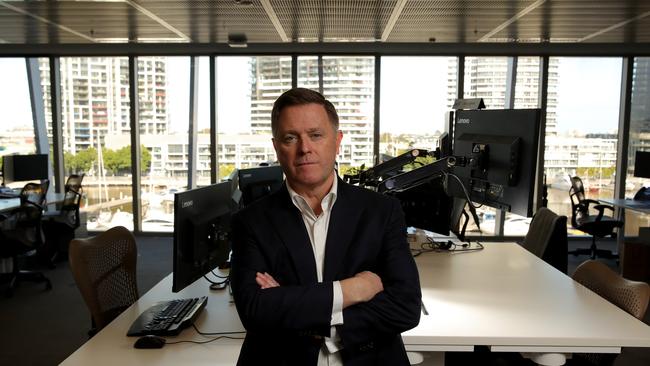ANZ tackles big carbon emitters in green loans push
A global push for net zero emissions by investors, corporates and regulators has convinced ANZ Bank to comprehensively overhaul its carbon policies.

A global push for net zero emissions by investors, corporates and regulators has convinced ANZ Bank to comprehensively overhaul its carbon policies, laying the foundation for a “massive” opportunity in sustainable finance and recognition as one of the world’s top banks for helping industries transition to a low-carbon economy.
Ahead of ANZ’s annual result on Thursday, institutional boss Mark Whelan said the bank wanted to use its expertise in debt capital markets and loan syndication to tap into huge growth in green finance — a global market worth about $US567bn ($793bn), including loans and bond issues, with a compound annual growth rate of 61 per cent.
However, carbon intensive companies could suffer, with ANZ initiating discussions two years ago with its 100 highest-emitting customers about their transition plans to a net-zero economy.
The customers — covering sectors including energy, transport, buildings, food, beverage and agriculture — have been quizzed about their public commitments to a net-zero economy.
Chief executive Shayne Elliott made headlines last month by warning that ANZ would exit any customer with a dismissive approach to the climate challenge, saying it would be a “red flag about good old-fashioned risk management”.
So far, ANZ has not exited any of its top 100 emitters.
Mr Whelan said the new climate framework was designed to position the bank “ahead of the game”, and was not a response to the pressure on bank lending policies from NGOs.
“We respect the position of the NGOs, but the changes are the result of shareholders and customers, as well as regulators taking a deeper view on these issues,” he told The Australian.
“Three years ago, we used to get one or two ESG (environmental, social and corporate governance) questions on investor roadshows, but now it’s the majority.
“This is a massive growth industry and we’ve been building our capability for four years — we think there will be a tsunami of activity.”
ANZ will target a range of investments as it seeks to fund or facilitate at least $50bn in sustainable solutions by 2025.
The bank pointed to opportunities in energy efficiency, low-emissions transport, green buildings, reforestation, renewable energy and battery storage, emerging technologies such as carbon capture and storage and hydrogen-based technology, disaster resilience and climate change adaptation measures.
ANZ’s rethink chimes with the European Union’s commitment to becoming the world’s first carbon-neutral continent by 2050.
The EU’s top energy official, Kadri Simson, wants to oversee the end of an 150-year era in Europe with the phasing out of coal-powered electricity and a huge investment in renewables.
On the investment side, the world’s biggest asset manager, BlackRock, has said it will dump shares in thermal coal companies from all its actively managed portfolios as part of a more forceful position on climate change.
Resources giant BHP has established a long-term goal of achieving net zero emissions for its operations by 2050.
At its annual result on Thursday, ANZ will unveil a range of targets consistent with the Paris Agreement’s goal of transitioning to carbon neutrality by 2050, and to help the development of new industries.
Importantly, there will be a ban on direct funding of any new coal-fired power plants or thermal coal mines, with existing loans to thermal coal mines expected to run off by 2030.
While diversified customers will continue to be supported, those with thermal coal exposures of more than 10 per cent of revenue will no longer be banked.
As a result, ANZ will further reduce the carbon intensity of its electricity generation lending portfolio by only directly financing low-carbon gas and renewable projects by 2030.
The bank will also seek “specific, time-bound and public diversification strategies” from existing customers with more than a 50 per cent thermal coal exposure, and will cap limits if they fail to meet this requirement and reduce its exposure over time.
Locally, activist group Market Forces, which presses companies to take faster action on climate change through shareholder resolutions, has previously targeted ANZ’s carbon policies as the weakest of the big four banks.
Unlike the other three majors, it had “failed to clear the lowest hurdle” of committing to exit thermal coal by 2030 in line with the Paris agreement, or set Paris-aligned targets for oil and gas.
More recently ANZ has made some notable moves, exiting lending relationships with half a dozen fossil-fuel based companies over the last two years.
The bank dropped out of a $1bn refinancing package for Whitehaven Coal earlier this year and participated in 37 sustainable financing deals, including 11 loans and 26 bond issues.
ANZ has also restructured internally to take advantage of the opportunity, with the resources, energy and infrastructure relationship teams now grouped under Christina Tonkin, ANZ’s managing director of corporate finance for institutional banking.
While Mr Whelan declined to comment on specific customers, he ruled out clipping the revenue ticket by facilitating access to debt markets for coal-fired power plants or thermal coal mines.







To join the conversation, please log in. Don't have an account? Register
Join the conversation, you are commenting as Logout